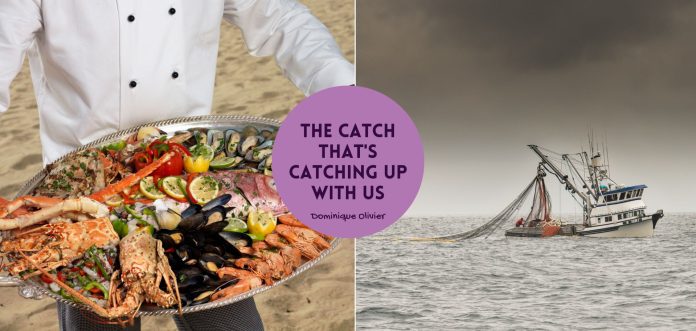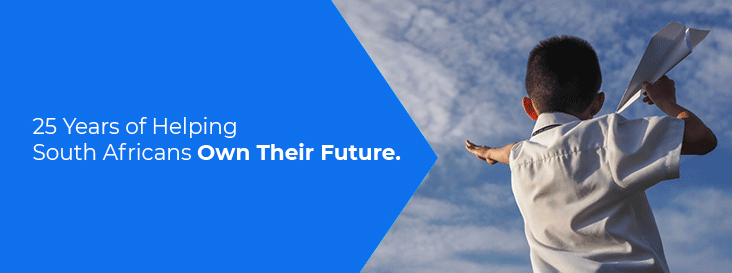Beneath the waves, a silent collapse is underway. As fish stocks dwindle, so do the jobs, meals and communities built around them. But it’s not too late for us to make a meaningful change.
Somewhere off the coast of West Africa, a trawler the length of a rugby field is scraping the seafloor with a net big enough to trap a blue whale. As it progresses, the heavy chain on the bottom lip of its net levels the terrain, smashing through rocks and corals and stirring up sediment from the ocean floor. It is fishing for one particular species of fish, but it will vacuum up everything in its path, from crustaceans to rays and even dolphins or small sharks. It is estimated that up to 75% of the creatures that die in this net will be tossed back into the ocean as by-catch – caught, but not sold or consumed. Even juveniles of the desired species, too young to breed and therefore illegal to sell, are raked up and discarded.
It is probably the most indiscriminate method of hunting that exists in our world today. To fully picture this level of destruction, you would have to imagine a reality where we burn down a hectare of bushveld in order to make it easier for us to shoot three springbok. It’s hard to think that we would tolerate this level of habitat demolition and waste if we could see it happening in front of us. But industrial bottom trawling happens where we can’t see it: far from shore, at the bottom of the ocean, concealed by water.
The trawler that I’ve just described to you is one of about 4 million fishing vessels currently ploughing the world’s oceans, chasing fish faster than nature can replace them. And depending on where you live in the world, your tax money might be helping it to do just that in the form of government subsidies that bail out struggling industrial fisheries.
Fishing, in theory, is a beautiful thing. It feeds half the planet. It provides jobs for 61.8 million people around the world. It supports entire coastal economies. But that’s the story you hear when the camera pans over a quaint harbour and a smiling fisherman holds up the morning’s catch. The real story – the one playing out in deep waters – is darker, messier, and deeply unsustainable.
Something fishy in the data
In 2022, the global fisheries and aquaculture industry smashed records, hauling in 223.2 million tonnes of aquatic animals and algae. It was the first time in history that farmed fish (aquaculture) outpaced wild-caught ones (capture fisheries). That sounds like a win for sustainability – more farmed fish means fewer fish taken out of the ocean, and surely that can only be a good thing, right? But take a closer look at the stats, and you’ll see where the problem lies.
We’re turning to aquaculture because we can no longer meet the demand for fish by catching them wild in the ocean. Wild fish stocks have plummeted worldwide while aquatic food consumption has grown twice as fast as the world population since the 1960s. Today, estimates suggest that the average human eats over 20kg of fish a year. 89% of aquatic animals caught or farmed go straight into our stomachs. The rest get pulverised into fishmeal or oil to feed (ironically) more farmed fish, or livestock, or even pets.
Overfishing isn’t just a buzzword for marine biologists; it’s the reality of a third of the world’s assessed fish species, which are pushed beyond their biological limits and unable to replenish fast enough. And that’s just the assessed ones. We don’t even have a full view of what’s happening in vast parts of the ocean.
Some of this overfishing is legal. A lot of it isn’t. Experts estimate illegal, unreported, and unregulated (IUU) fishing nets up to $36.4 billion a year for those willing to look the other way. That’s nearly the GDP of Ecuador, vanishing into the murky supply chains of high-value tuna, snapper, and squid. Illegal fishing often goes hand-in-hand with human rights abuses, flag hopping (when vessels change countries to dodge rules), and what insiders grimly call “fish laundering.” But the big problem isn’t just the pirates. It’s the fact that the entire system is structurally tilted toward taking more than the ocean can give.
So what about conservation?
Marine Protected Areas (MPAs) exist, but they vary widely in terms of rules and enforcement. Some allow fishing, others allow tourism, many allow both. It’s not uncommon to find MPAs that operate more like lightly managed parks than true sanctuaries. The argument for these flex arrangements is that completely banning human activity is politically difficult, especially when fishing and shipping are so deeply woven into national economies.
As of 2020, only about 7.5% to 8% of the world’s oceans are under some kind of conservation status. That’s roughly 27 million square kilometres, or about the size of Russia and Canada combined. When it comes to actual no-take zones, where all fishing and exploitation are completely off the table, just 1.89% of the ocean is covered by fully protected, no-take marine reserves. That means the overwhelming majority of the ocean (including most of the areas that have a ‘protected’ label) are still open to fishing, and in some cases, even trawling.
It’s tempting to think of overfishing as an environmental issue; something that affects coral reefs and endangered turtles. Something that sits in the realm of marine biologists and blue-planet documentaries. But that’s only half the story.
Where environment meets economy
The truth is, if we collapse fish stocks, we’re not just losing biodiversity – we’re pulling the plug on an industry that supports and feeds millions of people globally. When the fish go, so do the jobs, the incomes, and the communities built around them.
Back in December 2022, over 190 countries signed on to the Kunming-Montreal Global Biodiversity Framework. The framework includes 23 targets, all aimed at halting the rapid decline of the habitats, species, and ecosystems we rely on. One target in particular, helpfully nicknamed “30×30”, has become the headline act. It calls for 30% of the world’s land, freshwater, and oceans to be effectively protected and managed by the year 2030. Emphasis on effectively, because the goal isn’t just to draw neat little borders on a map. It’s to actually make those areas safe from destruction.
The default position, in this vision, is protection. You start with the idea that 30% of the ocean should be deemed no-take zones. If any fishing is allowed around these areas at all, it should be minimal, carefully managed, and in the hands of local communities, not massive industrial fleets vacuuming up entire ecosystems for export.
Why would we do this? Because when you give marine life space to recover (meaning no boats, no nets, no interruptions), fish populations tend to bounce back. This has been demonstrated and proven across multiple existing no-take zones. And since there are no borders or fences in the ocean, these growing populations don’t just stay in their protected no-take areas. Once fish are breeding and growing in peace, their offspring start to drift outward, spilling over into surrounding waters where fishing is allowed. So even if the total area where fishing is permitted shrinks, the amount of fish being caught can actually go up.
That’s the counterintuitive magic of doing less: when we stop chasing every last fish, we get more and better fish in return. Not to mention healthier oceans, stronger food systems, and coastal economies that don’t have to live or die by whatever the trawlers left behind.
Change on a plate
We can’t treat overfishing as a niche environmental concern for scientists and scuba divers. It’s an economic time bomb. And if we want to defuse it, we need to start with accountability.
That means pushing governments to phase out harmful subsidies that reward overcapacity and destructive fishing. It means following up on progress made towards 30×30 goals and putting pressure on decision-makers where possible. It means asking uncomfortable questions about where our seafood comes from, who benefits from its trade, and who’s left paying the price. And it means using our power as consumers to support the alternatives that already exist.
In South Africa, that includes home-grown initiatives like Abalobi, a brilliant local platform that connects small-scale fishers directly to consumers, restaurants, and chefs. Every fish is traceable, responsibly caught, and fairly priced, meaning you’re supporting sustainable livelihoods and healthier oceans in one swipe. These are the choices that matter. Not everyone can control government policy, but we can all control what lands on our plates. If we want a future with fish – and with jobs, and functioning coastal economies – we have to stop treating the ocean like a bottomless buffet.
Because it isn’t. And once we’ve trawled it bare, there’s no subsidy on earth that can bring it back.
For more on this topic, be sure to watch Sir David Attenborough’s brilliant documentary Ocean.
About the author: Dominique Olivier

Dominique Olivier is the founder of human.writer, where she uses her love of storytelling and ideation to help brands solve problems.
She is a weekly columnist in Ghost Mail and collaborates with The Finance Ghost on Ghost Mail Weekender, a Sunday publication designed to help you be more interesting. She now also writes a regular column for Daily Maverick.
Dominique can be reached on LinkedIn here.





Another great article, well done!
Can you also look into farming that makes use of tillage? The amount of topsoil running off into the sea is astronomical, far more than is realised. I have intimate knowledge of the Breede estuary stretching back to the 1960s. No-one thought that a river tidal over 63 kms could possibly silt up, given the torrent flowing through the mouth twice a day with the tides. However, that is exactly what is happening. The river is about half the depth it was back in the 60s and I suspect it will silt up at an increasing pace as less and less water flows through the shallow bar. Adding to this crisis is the increased usage of centre-pivot irrigation, which is drawing water from the river and further reducing the flow. Finally, major dams, such as Brandvlei and Theewaterskloof serve to reduce the natural pattern of flooding. I hate to say it, but maybe our environment would be better off if grain farms were rather put to pasture. After all, isn’t insulin resistance, from a gain-rich diet, also the primary cause of obesity?
I think you’ve got enough information there to write an article of your own Rob! And an interesting one at that.
Thanks Dominique. Hard hitting and to the point. Problem is that politicians and most humans on the planet don’t understand and even less care. They don’t have the mental capacity.
Thanks so much Johan, I’m glad it struck a cord!
Thank you. This is yet another bottomless pit of report, protest and….nothing! All the losses are glaring, & ignored. Are there activists mobilising, like we did, to stop seismic exploration?
Thank you for the excellent article. However, I am absolutely shocked that this devastation under water at sea has never been headline news! Are we as a society so ignorant with a could not care less attitude! What we don’t see does not exist?
Brilliant article documenting a very sad reality. Unfortunately, “out of sight, out of mind” is a neat summary of a number of issues, particularly environmental ones. Similar to the Cape Town drought, people only really started to comprehend the severity of the situation when taps started to dry up. Fortunately, there were enough smart people and, probably more so, collective vested interest to ensure that the problem was remedied. I hope it doesn’t take the shutting down of local fish and chips shops at the V&A Waterfront and the like for people to finally start taking notice!